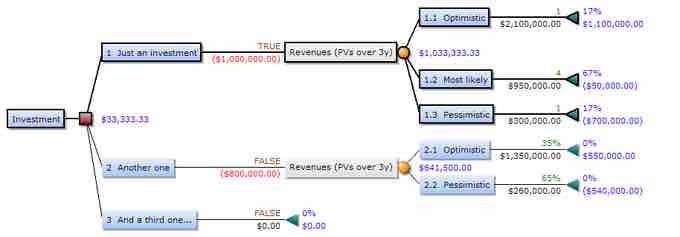Once a decision has been defined, the next step is to identify the alternatives for decision makers to select from. It is rare for there to be only one alternative; in fact, a goal should be to identify as many different alternatives as possible without making too narrow a distinction between them. The decision maker can then narrow the list based on analysis, resource limitations, or time constraints. Often, doing nothing is an alternative worthy of consideration.
Brainstorming
Brainstorming is a good technique for identifying alternatives. Making lists of possible combinations of actions can generate ideas that can be shaped into alternatives. Often this is best done with a small group of people with different perspectives, knowledge, and experience. A formal approach to capturing the results of brainstorming can help make sure options are not overlooked.
Another way to evaluate alternatives is through a decision tree.
Decision Trees
A decision tree is a decision support tool that uses a structured graphical depiction of alternatives. This method creates a visual depiction of choices so decision makers can have a clearer understanding of them. Decision trees help divide larger decisions into smaller ones and are useful for uncovering all available options.
Decision trees have a starting point and then branch out, with each branch representing a different event, action, or outcome. Resource costs, benefits, and probabilities can be recorded by each option.

Applied decision tree
Decision trees can improve investment decisions by optimizing them for maximum payoff.
Decision trees have three types of nodes at each part of the diagram:
- Decision nodes: these are the alternatives themselves and represent the point where a decision must be made.
- Change nodes: these are points where choices must be made; in their simplest form these may be represented by Yes/No or Go/No Go options.
- Conclusion or end nodes: these are the points that appear when there are no more alternatives or choices to be made, and they state the outcome of a particular decision branch.
When generating alternatives, decision makers use information gathered by defining the problem. The list of alternatives can then only be as good, complete, and accurate as the quality of that data. Overlooking factors or dimensions of an issue or problem can mean missing viable alternatives. The alternatives identified become the basis for subsequent analysis and ultimately the decision itself.